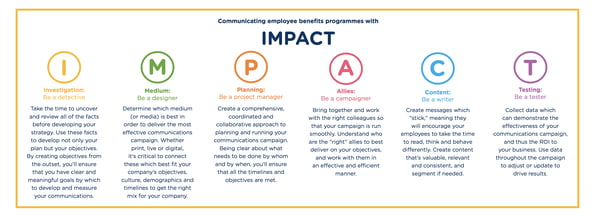
7 min read
Once upon a time, I built what my team and I thought was the best recognition programme ever. It was fantastic, and we were extremely proud of it.
But when I pressed go and released it into the world…nothing happened. So much so, that I actually went back to check that I had indeed pressed go. I had . . . unfortunately!
Has this ever happened to you? Have you ever not received the results or impact that you had hoped for, or needed, to achieve a specific objective?
I can almost guarantee that a large part of this failure was down to a lack of communication. Something so key, so essential, to our success, but something that is so often overlooked or done incorrectly.
It is for this reason that I wrote my first book, Effective HR Communication: A Framework for Communicating HR Programmes with Impact, and created the IMPACT model, in the hope that others like yourself wouldn’t make these same mistakes.

There are two parts of the model, one focusses on the key steps required to successfully communicate your programme, and the other focuses on the "hat" that you need to put on to set the stage, and to become the character you need to play to achieve success.
IMPACT. It stands for Investigation, Medium, Planning, Allies, Content, Testing, and are the key steps to be followed whenever you’re communicating recognition programmes to your staff.
For each step we explore, I want you to assign yourself a different hat. For Investigating, you’re a detective. Medium, you're a designer. Planning – nice and simple – a planner. Allies, that's when you're a campaigner. Content, you're a writer. T, you're a tester.
Before we go into the model, let me share some objectives with you. These are the key ingredients or props you’ll need to set the stage and get the best communications campaign:
-
Shared meaning. That’s what you say, not just what the person hears. Make sure you achieve this or your audience will walk out of your "play" not getting the plot.
-
Call to action. I’m talking bold letters, inclusion in the title. People need to know what they're going to do next or put simply, why bother?
-
ROI. Here’s where you think about what you’re getting for your investment in time and money. Make sure you’re getting value from both.
Now, it’s time to apply the IMPACT model, put on your hat, and communicate your programme to the world and explore the guiding principles for each step.
Investigation: Get the details
It’s time to put on your detective hat. You need facts, and you’ll get these by talking to your employees and key business partners. Dig deep and make sure you discover every little detail out there, and like a detective, leave no stone unturned.
Years ago I worked for a company where a common way of communicating with our locations scattered across the county was through videos. We’d create these lovely videos, send them out to the locations, and ask our HR business partners to play them for our employees to hear the messages. That was until I received a call from one of the HR directors who said, "Do you know what, Deb? We don't have any sound on our computers. No sound whatsoever." Ouch, hard to effectively communicate when your employees aren’t even receiving the messages!
The other half of this step is to create your objectives, investigating and deciding upfront what you need to through your communications to achieve success. Don’t skip this or like the lack of sound with my videos, you’ll have a lack of direction with your communications.

Medium: Choosing an employee communications channel
Now it’s time to put your designer hat on, and get creative with the tools you’re going to use to communicate your messages. The good news is that there’s a lot of choice out there these days, with tons of media to choose from. Common ways to group them are in these three categories: 1) Face-to-face, 2) Print, 3) Digital.
If you’re confused by all of this choice, wondering how in the world you’ll decide which one or ones are “right,” then ask yourself what I call the four “fit” questions?
-
Objectives: What is going to fit your objectives and get you that employee engagement ROI or whatever other objectives you may have set?
-
Culture: Do your staff use WhatsApp more than email, love or hate social, what aligns or fits with how you like to communicate at your company?
-
Audience: Remember, you might have multiple audiences! What will reach an fit them best?
-
Timelines: Be realistic — how much time will your communications take? What stakeholder approval will you need, and how much time is required to fit your ultimate timelines?
Plan: How to plan a successful employee communications campaign
Unfortunately, there is no magic switch that will automatically roll out all of your communications for you (wouldn’t that be nice if there was?). You’ll need to put on your project manager hat for this step, and figure out what, when and who is going to get the work done.
What I’ve learned the hard way when it comes to planning is that if you don’t think through all of the details and gain agreement on them upfront, your campaign has no chance of succeeding.
Think back to my example of the videos, had I built into my plan a step to gain agreement from business partners, I would have known sooner rather than later that it wouldn’t work. Equally important is to address the risks. What could go wrong, what is your plan B? Say you’re dropping chocolates on everybody’s desk. What if you can’t get into one of the offices, or if you run out of chocolates? Make sure you have a plan to cover the unexpected.

Allies: Find your partners
The “A” in IMPACT stands for allies, and for this step I’d like you to wear the hat of a campaigner, someone who owns and drives change. This step, like the last one, is often overlooked either because we think we can do it ourselves or we don’t want to bother our business partners. But trust me, that’s exactly when problems occur, for if you don’t have them on your side or on your team, mistakes can and will happen.
Think of allies like a part of a relay team. If you run the race on your own you’ll most certainly finish last, if you don’t select the right ones or don’t partner with them properly throughout the race the baton will be dropped along the way, and you’ll finish last. Certainly not results you want to achieve.
Content: Create engaging communications
Content is the words and images that you choose to create focus and interest, wearing the hat of a writer, as you bring these ideas to life to tell a story and share key messages.
When creating your content, there are three guiding principles to keep in mind. The first is to address the inevitable question “what’s in it for me?,” showing employees why and how it is valuable to them.
Secondly, think about ways to make it relevant to them, so why should they care and pay attention?
And finally, how are you going to make your content consistent, so hang together through employer branding, etc. to bring your story and messages together.

Testing: Measure the effectiveness of employee communications
The final letter in the model, “T,” stands for testing, and is important to do throughout the process to test and monitor the effectiveness of your programme and your employee communications. Wearing the hat of you guessed it, a tester, ask yourself – Do your employees understand the key messages? Are they taking the appropriate action(s)? You can then use all of the data to demonstrate your ROI.
If something goes wrong, be flexible, nimble and use that data to your advantage. Don't be afraid to admit that you've done something wrong. If it's not working, try something else. Your employees will understand, so try find something help you achieve your objectives.
Remember, don’t get fixated on the order of these steps. They just happened to spell a great word! But if you tackle your next project using these steps and working in tandem, no matter the order, you’ll keep things running smoothly.
A last word…
If one or more parts of the IMPACT model are not your specialty or you think you don’t have enough time to do them all, you might be tempted to skip or ignore them. Resist! Ask yourself, if you were doing a play, would you just scrub a key character or instead find someone else to play the role? Do the same when it comes to your communications campaign, and find someone else who can help – an ally, perhaps! Think back to the relay team, join forces to make it happen and to win.

 Debra Corey
Debra Corey

